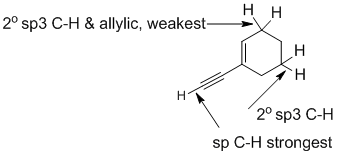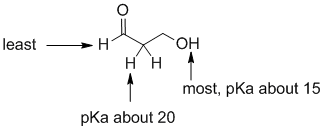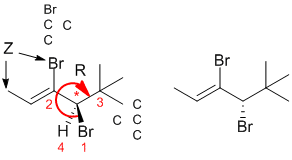| Qu1: |
Acidity of phenols.... all are -OH systems and differ in a different atom remote from the OH: H vs F vs Cl. Look at the conjugate base and think about how the nearby electronegative atom will help.... F is the most electronegative so it will stablise the O- the most, thus making the o-fluorophenol the most acidic. Cl is not quite as electronegative but it will have a similar but smaller effect than the -F. |
 |
| Qu 2: |
Counting types of H |
 |
| Qu 3: |
C-H bond strength depends on the hybridisation of the C atom. sp hybrid orbitals have more s character and so are smaller which leads to shorter, stronger bonds. The proximity of a p system (here an alkene) makes adjacent C-H bonds weaker (the e rich character of the p system allows the adjacent C-H bonds to lengthen and therefore weaken). |
 |
Qu 4: |
Basicity...either think about the availability of the electrons in the bases, always a good idea to draw in the lone pairs because lone pairs are more available than bonded pairs. Then it's O vs N and because N is less electronegative than O, N is the better electron donor. |
 |
| Qu 5: |
Radical stability order and the hydrocarbon reactivity experiment helps answer this question. Tertiary more stable than secondary and resonance can further stabilise radicals. |
 |
| Qu 6: |
Alcohols (pKa about 15) are more acidic than aldehydes (pKa about 17-20) since the H involved is on an electronagtive O rather than C. FOr an aldehyde, it is the position adjacent to the C=O NOT the H attached to the C=O that is more acidic due to the extra resonance stabilisation of the enolate conjugate base. |
 |
| Qu 7: |
Ranking resonance structures... Normally look to maximise the number of bonds or atoms with complete octets and minimise charge separation. Carbocations are C atoms with incomplete octets while the O+ still has a complete octet. |
 |
| Qu 8: |
Basicity...either think about the availability of the electrons in the bases, always a good idea to draw in the lone pairs because lone pairs are more available than bonded pairs. Cl- is the conjugate base of a strong acid, HCl. Due to the size and electronegativity of Cl, Cl- is a very weak base. The other two are O- systems, but in the carboxylate there is resonance delocalisation and the inductive effect of the Cl stablising the conjugate base compared to the simple alkoxide. |
 |
MOLECULAR PROPERTIES:
No real method here, really just do you know various aspects of molecular structure and apply it to the molecule(s) in question. |
| Qu9: |
The structure contains 3 rings, 7 C=C and 1 C≡C therefore index of hydrogen defficiency = 3 + 7 + 1 x 2 = 12. (v1 E, v2 A) |
| Qu10: |
The key to acidity is conjugate base stability. A key factor in that, is the nature of the atom the H is attached to. For C and O systems, H on O are typically more acidic because the electronegative O can better stabilise the negative charge. Here, only the O atoms at O1 and O19 have H attached. O1 is a phenol and O19 an alcohol. Phenols are more acidic than alcohols because the -ve charge can tbe delocalised on to the aromatic C. Phenol pKas about 10 and alcohols pKa about 15. So O1 is the most acidic site. (v1 A, v2 A) |
| Qu11: |
For C10 assign the R/S stereochemistry, using the Cahn-Ingold-Prelog rules to assign group priorities....O > C(C=C)C > C(C=C)H > H. Since the lowest priority group, the H is at the front, we need to look at it from the opposite side (build a model, redraw or visualise) where the sense of the 3 higher priority groups (1-2-3) is clockwise = R. For C16=C17 assign E or Z to the alkene based on the priority rules at each end of the C=C unit. At C16, C > H and at C17 C > H, therefore the higher priority groups are on the same side = Z. |
| Qu12: |
Oxidation states...count the bonds attached to the atom being considered. A bond to a more electronegative atoms counts -1, a bond to the same type of atom counts 0 and a bond to a less electronegative atom (e.g. H) counts +1. Total the count and then consider the formal charge on the central atom since the oxidation state for the central atom plus the groups attached must equal the atoms formal charge. For C15 the C is attached to 2 x C (count 0 each), O (count -1) and H (count +1) therefore total = 0 and therefore the oxidation state C = 0. (v1= B, v2 = C) |
| Qu13: |
Functional groups....the group in the box is a C-O-C unit, an ether. (v1 =C, v2 = E) |
| Qu14: |
Triple bonds are stronger than double bonds than single bonds due to the increased bonding due to the multiple orbital interactions so C13-C14. (v1 = B, v2 = C) |
| Qu15: |
O9 is attached to two sp3 C atoms so it too is sp3 hybridised. Therefore, the lone pairs on the O are both in sp3 hybrid orbitals (v1 = A, v2 = E) |
| Qu16: |
O2 is attached to an sp2 C and an sp3 C. This means there is a resonance interaction of the O with the benzene ring, meaning the O needs to be treated as sp2 hybridised. C13 is part of a triple bond, with two groups attached, it is sp hybridised. |
| Qu17: |
C18 is attached to two C atoms so it is secondary. It is also adjacent to an alkene ring so it is allylic. (v1 = AD, v2 = BD) |
SPECTROSCOPY:
Use the IR spectra provided to get the functional groups that are present in the structures, so look for the key groups : C=O (near 1700 cm-1) , -OH or -NH (above 3000 cm-1), aromatic C=C (two bands 1600-1400 cm-1), C-O (near 1200 cm-1) and triple bonds (near 2200 cm-1).... use the tables as needed. |
| Qu18: |
This IR has few absorptions. It does not show a C=O, -OH or -NH, or C=C, or triple bonds. The only functional group band appears to be a C-O just above 1100 cm-1. The C-H stretches are < 3000 cm-1 indicating sp3 C-H only. The only other major band is the C-O just above 1100 cm-1, so this eliminates just about everything except for the ether (v1 AB, v2 C) |
 |
| Qu19: |
The IR shows a C=O a little above 1700 cm-1. The IR does not show -OH or -NH, or C=C, or triple bonds. There appears to be a C-O just above 1200 cm-1. On closer inspection, the C-H stretches are < 3000 cm-1 indicating sp3 C-H only. This would be consistent with an ester (v1 BC, v2 BC) |
 |
| Qu20: |
The IR does not show a C=O, -OH or -NH or triple bonds. There looks to be C=C just above 1700 cm-1 and on closer inspection, there are C-H stretches above and below 3000 cm-1 indicating both sp3 and sp2 C-H. This indicates the alkene (v1 B, v2 B) |
 |
| Qu21: |
The IR shows a strong and broad OH stretch at 2500-3500 cm-1, and C=O near 1700 cm-1 (look for a carboxylic acid) but no Ar C=C near 1600
cm-1. Therefore the IR is of butanoic acid (v1 CD, v2 E) |
 |
| Qu22: |
The IR shows a C=O just above 1700 cm-1. There are no -OH or -NH, C=C or triple bonds. Therefore this is the ketone (v1 AE, v2 AE) |
 |
| Qu23: |
The IR does not show a C=O, -OH or -NH or C=C. There looks to be a triple bond near 2200 cm-1 and on closer inspection, the C-H stretches are < 3000 cm-1 indicating only sp3 C-H. This rules out the terminal alkyne and indicates the nitrile (v1 D, v2 AC) |
 |
NOMENCLATURE:
Two types of questions here, however it is a good idea to use key descriptors like E and Z, R or S, cis or trans, numbering, functional group etc. to help screen the answers before getting too tied up in the words. For the first four, name the compound and then match it to the list, for the last four
use the key descriptors and check each molecule in turn. So this section really depends on the nomenclature rules. |
| Qu24: |
An alkane with the longest chain C8, so an octane. There are two substituents, a simple ethyl group and a complex substituent, a 1,1-dimethylethyl group. These need to be numbered 4,5 and alphabetisation means that the dimethylethyl group is named before the ethyl group since the first letter in the brackets is used from complex substituents when alphabetising such systems. Hence, 4-(1,1-dimethylethyl)-5-ethyloctane (v1 B, v2 B) |
|
| Qu25: |
The longest chain is C6, so a hexane. The principle functional group is a ketone, so the suffix "-one" is required but there is also an alkene that needs to the "ene" suffix. Number to give the ketone the lowest number means hex-4-en-3-one. The double bond is trans, so we have trans-hex-4-en-3-one (v1 B, v2 E) |
|
| Qu26: |
The principle functional group is the alkene and those two C atoms need to be 1 and 2. It's a five membered ring (cyclopentene). Then the first point of difference rule requires that the system be numbered as a with the methyl group at C1 rather than C2. This means we have 5-ethyl-1-methylcyclopentene. (v1 B, v2 A) |
|
| Qu27: |
The longest chain is C6, with an alkene as the principle functional group so a hexene. Need to number to give the alkene the lowest number, i.e. -2-ene. We have an isopropyl substituent which needs to be numbered as 3-. To determine the E/Z we need to prioritise the substituents at each end of the C=C. At the right hand end, the CH3 > H, at the left, the isopropyl (C to CCH) outranks the propyl (C to CHH). This means the higher priority groups the methyl and the isopropyl are on opposites sides (E). Hence we have E-3-isopropylhex-2-ene. (v1 A, v2 B) |
|
| Qu28: |
All of the systems are ethers, it's all about the substituents. Benzyl is a C6H5CH2- and the C4 alkyl group is isobutyl which requires a methyl branch at the end of the chain (see figure). |
 |
| Qu29: |
Substituted benzenes, nitro is -NO2 and phenol is an aromatic alcohol, Ar-OH. ortho means the two groups are adjacent. -NH2 is an amine which would mean an aminobenzene or an aniline. |
 |
| Qu30: |
R/S stereochemistry and E/Z stereochemistry
Chirality center is marked with a *. Priority of groups there is Br > CBr > CC > H. With Br forwards, the chirality is R, so we need the Br to be back.
Double bond has CH3 > H and Br > C therefore, higher priority groups need to be on the same side = to be Z. |
 |
| Qu31: |
The bicyclic system is an octene meaning 8C and an alkene. The [3.2.1] indicates the number of C is each link between the bridgehead carbons. Need to start to number from a bridgehead, going along the longer link first to locate C6 for the alkene and the methyl group. |
 |












